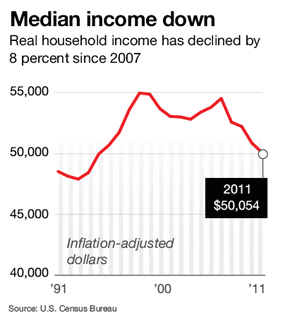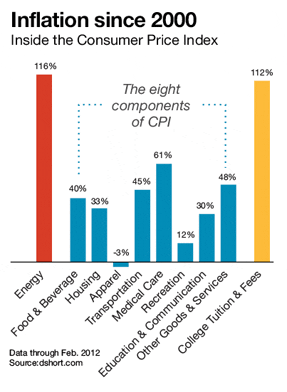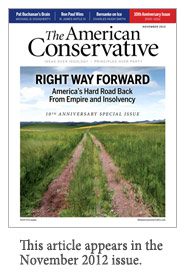An Iceberg Called Bernanke

No wonder the policies of the Federal Reserve are so widely misunderstood: in many ways the Fed is like an iceberg, with its public pronouncements being only the visible 10 percent above water. The real mass of the Fed’s actions lies beneath the surface, invisible to us mere citizens.
Consider the Fed’s public mandate, which is to “promote stable prices, maximum sustainable output and employment.” This is solid public relations, selflessly focused on the good of the nation, but it’s also deeply disingenuous, as the Fed’s less PR-pretty agenda is rather obviously to preserve the banking sector’s profits and power.
We can find clues to the Fed’s real goals in its actions behind closed doors—the 90 percent of the iceberg that’s out of public view.
On the surface, the Fed has increased its balance sheet by about $2 trillion since the 2008 global financial crisis. This electronically created money purchased about $1.1 trillion in mortgage-backed securities (MBS) to support the housing market and $1 trillion in Treasury bonds to keep interest rates low. These two goals—super-low interest rates (also known as “zero interest rate policy,” or ZIRP) and supporting assets such as housing and stocks—are the core strategies the Fed publicly deploys to boost growth and employment.
Supporting the banks is not mentioned, for obvious PR reasons. Yet a Government Accountability Office audit found that the Fed provided $16.1 trillion in “emergency program” loans to global banks from 2007 to 2010. A Levy Institute study uncovered a total of $29 trillion in Fed support—roughly ten times larger than the Fed’s public programs. For context, the annual U.S. gross domestic product is about $15 trillion.
This suggests we should take the Fed’s assurances that its policies are all for the public good with a grain of salt roughly the size of the Fed’s D.C. headquarters at 20th and Constitution Avenue.
Did bailing out the banks truly serve the public good, or did it stymie much-needed “creative destruction” of failed financial institutions that have grown so powerful that they are now “too big to fail”? How exactly did enabling the banks to draw upon trillions of dollars of Fed support, safe from Americans’ scrutiny, serve the public good?
Managing Perceptions
Here’s the other primary source of misunderstanding: the Fed cannot directly funnel money into the real economy, it can only funnel money into the banks. Its actions are indirect. This sets up a peculiar mismatch between the Fed’s public goals and its levers of control: it can’t actually increase employment, it can only flood the banks with credit and hope that individuals and enterprises will borrow money and inject it into the real economy, (hopefully) boosting employment.
In other words, the only way the Fed can trigger changes in the real economy is to manage perceptions in order to stimulate borrowing and spending. In effect, the Fed has two public-relations tasks: one is to persuade households and businesses to borrow and spend profligately as a means of growing the economy, while at the same time the central bank must mask the project of preserving the “too big to fail” banks behind a façade of public policy that is long on persuasion and short on mechanisms to help real people in the real economy.
Take housing as an example. The Fed’s initial $1.1 trillion in MBS purchases has had remarkably little effect on the moribund U.S. housing market, but this didn’t stop the Fed from announcing another $40 billion per month of MBS purchases from now until housing re-inflates (or doomsday, whichever comes first) as part of the third round of quantitative easing (QE3).
How exactly does the Fed’s investment in impaired mortgages help homebuyers and homeowners? The Fed’s answer is that transferring dodgy mortgages from struggling banks to the Fed’s balance sheet helps banks originate more mortgages and lowers mortgage rates for buyers and homeowners who are refinancing existing mortgages.
This is an indirect way of aiding homeowners, but it is a very direct way of aiding banks, who have dumped $1 trillion in impaired mortgages—over 10 percent of the nation’s total—onto the Fed, which kindly exchanged hard cash for assets that were worth a fraction of the face value paid by the central bank. If that wasn’t a transfer of “free money” designed to bolster bank reserves, what was it?
As a thought experiment, imagine an alternative policy where the Fed paid off $1 trillion of underwater mortgages, leaving the overjoyed owners free of mortgage payments and the equally overjoyed banks with the cash. Setting aside the ethical ramifications of such a policy, that would certainly boost household spending and consumption—precisely what the Fed claims it seeks—while achieving the same goal of handing the banks cash for hopelessly impaired mortgages.
In the real world, one-third of U.S. homeowners are “underwater,” with mortgages that exceed the value of their homes, and a significant percentage of the remaining households no longer qualify for refinancing or a mortgage of any sort other than the government-subsidized variety. The banks have been aided by Fed policy, but little of the largesse has trickled down into the real economy.
This is the basic problem with the Fed’s policies: unable to funnel money directly to households, it can only affect the real economy by modifying the internal psychological states of consumers.
Jedi Mind Trick: You Will Borrow More Because You Feel Wealthier
 So the Fed is attempting two Jedi mind tricks: one is to spark enough inflation to change our expectations of future inflation. If you’re confident that your cash will be worth less next year, you’re highly incentivized to spend it now rather than see its purchasing power decline. This is called bringing demand forward, and the weakness of this policy is painfully obvious: if you persuade all of next year’s vehicle buyers to purchase a car this year, then sales plummet next year.
So the Fed is attempting two Jedi mind tricks: one is to spark enough inflation to change our expectations of future inflation. If you’re confident that your cash will be worth less next year, you’re highly incentivized to spend it now rather than see its purchasing power decline. This is called bringing demand forward, and the weakness of this policy is painfully obvious: if you persuade all of next year’s vehicle buyers to purchase a car this year, then sales plummet next year.
The other problem with generating inflation to change expectations is that it only works if earnings rise along with the cost of goods and services. Alas, the Census Bureau reports that real household income—that is, adjusted for official inflation—has declined 8 percent since 2007. This is horribly counterproductive to the Fed’s stated goals, as households with less income have a harder time paying debt, a harder time qualifying for more loans, and less money to spend on goods and services. Meanwhile, inflation bubbles along, robbing households’ purchasing power at a 2–3 percent clip annually. In the 12 years since 2000, medical care has shot up 61 percent, energy has jumped 116 percent and college tuition has skyrocketed by 112 percent. Many economists believe that the unmassaged rate of inflation is higher than the official rate, but even the official rate has devastated households.
 The second mind trick is known as the wealth effect, which Fed Chairman Ben Bernanke recently described: “If people feel that their financial situation is better because their 401(k) looks better for whatever reason, or their house is worth more, they are more willing to go out and provide the demand.”
The second mind trick is known as the wealth effect, which Fed Chairman Ben Bernanke recently described: “If people feel that their financial situation is better because their 401(k) looks better for whatever reason, or their house is worth more, they are more willing to go out and provide the demand.”
The key phrase is “for whatever reason.” In other words, it doesn’t matter how artificial the increase in their assets may be, any increase is presumed to be good enough to trigger a “wealth effect” that generates a pressing urge to borrow and spend.
Since incomes are declining in all brackets, the Fed’s “solution” is to encourage more borrowing and spending—more demand for goods and services. But the wealth effect is an entirely internal psychological state that is highly dependent on trust that the wealth increase visible on the 401(k) statement isn’t fleeting. The Fed’s massive and very public intervention in housing, bonds, and stocks actually erodes that trust, for people intuitively grasp that manipulated markets are not to be trusted.
Are the Fed governors really so intellectually myopic that they can’t recognize that people now understand the difference between central-planning manipulation and a legitimate bull market?
Even more ominous for the Fed’s mind trick, those who look at their income and its dwindling purchasing power feel poorer in the real world, and a nudge upwards in home or stock valuations doesn’t change the real-world sense that their income is buying less.
Relatively few Americans are seeing any significant expansion of paper wealth: 83 percent of all stocks and bonds are owned by the top 10 percent of households. The bottom 90 percent feels little if any wealth effect from a rise in equities.
Regardless of one’s view of income disparity, the fact that only the top 5 percent of U.S. households are paying down debt, i.e., deleveraging, reveals the futility of the Fed’s plan to encourage spending in households with declining incomes.
Is it any wonder the mind tricks aren’t working?
The Fed’s “Beautiful Deleveraging”
Financier Ray Dalio recently described what he termed “beautiful deleveraging.” To understand the phrase we have to start with one of the core problems in the American economy: we’re over-indebted and overleveraged, which means that incomes and assets (collateral) no longer support the debt that was taken on in the bubble years.
There are only three ways to deleverage an over-indebted private sector: write off the bad debt—i.e., lenders absorb the losses or close their doors—increase the income of the borrowers with inflation so it’s easier for them to make debt payments, or use public funds to bail out the lenders, squeezing public spending.
“Beautiful deleveraging” combines equal doses of austerity, write-downs, and inflation to gradually lighten the load of impaired debt. This is Goldilocks deleveraging. Each component is “not too hot, not too cold”—inflation is modest, write-downs of bad debt are gradual, and austerity is not too severe. Given enough time, the leverage and debt are worked off without requiring any structural change to the status quo.
Understandably, those who benefit from the status quo have embraced this solution for the appealing reason that it doesn’t change the power structure. Everyone currently in charge remains in charge, and everyone who controls outsized wealth continues controlling outsized wealth. Rather than falling onto the politically powerful “too big to fail” banking sector, the pain of deleveraging is spread over the entire economy. Since there is no such thing as painless deleveraging, this “solution” distributes the pain over hundreds of millions of people. That’s what makes it “beautiful” to the status quo: it doesn’t cost them their power or their wealth.
This is a rerun of the game plan that worked in the last banking crisis of the early 1980s: don’t force the banks to declare their losses but “extend and pretend” while offering them risk-free ways to rake in billions in profits. The goal was to enable the banks to recapitalize “painlessly” on the backs of consumers and taxpayers, who continued to pay high margins on debt and taxes to fund financial-sector bailouts.
The other explicit goal of the Fed’s strategy is to create modest inflation by brute-force expansion of the nation’s money supply. This inflation is “good” because it enables debtors to pay off their debts with cheaper dollars, and it also serves to reinvigorate the “animal spirits” of borrowing and spending that the Fed views as the foundation of growth. But as we have seen, inflation has backfired, as a relentlessly globalized economy and structural surplus of labor have lowered real incomes across the board. “Beautiful deleveraging” has morphed into “ugly inflation” that saps purchasing power and the ability to leverage more debt.
 How about those super-low interest rates? Banks can borrow from the Fed at zero percent, but real people in the real economy are still paying stiff rates: the average interest on credit cards has declined from 19.9 percent to 14.52 percent—but only if the consumer has outstanding credit. Student loans in federally guaranteed programs have rates of 6.8 percent and 7.9 percent to 8.5 percent for PLUS loans, very hefty returns in a ZIRP economy. Meanwhile, interest on cash savings draws near-zero yields—another counterproductive “gift” of Fed policy, as ZIRP has shaved billions of dollars from household incomes.
How about those super-low interest rates? Banks can borrow from the Fed at zero percent, but real people in the real economy are still paying stiff rates: the average interest on credit cards has declined from 19.9 percent to 14.52 percent—but only if the consumer has outstanding credit. Student loans in federally guaranteed programs have rates of 6.8 percent and 7.9 percent to 8.5 percent for PLUS loans, very hefty returns in a ZIRP economy. Meanwhile, interest on cash savings draws near-zero yields—another counterproductive “gift” of Fed policy, as ZIRP has shaved billions of dollars from household incomes.
The Fed’s public policies have not just failed to stimulate productive growth; they have triggered deeply counterproductive forces. Out of sight, the Fed’s project of preserving bank wealth and power has succeeded, at a very high cost to households struggling in the real economy.
Charles Hugh Smith is the proprietor of the Of Two Minds blog and author of An Unconventional Guide to Investing in Troubled Times.
Comments